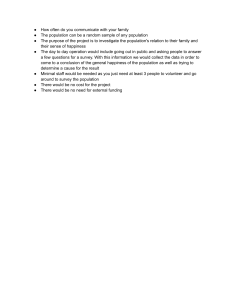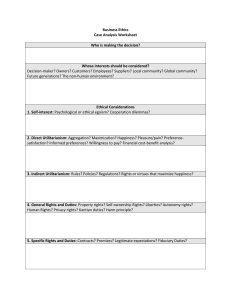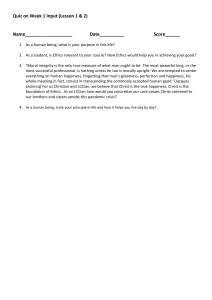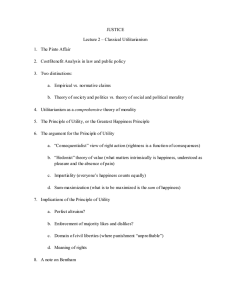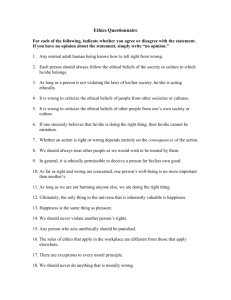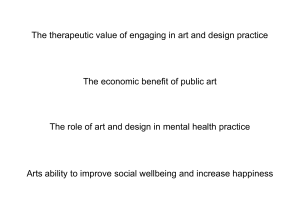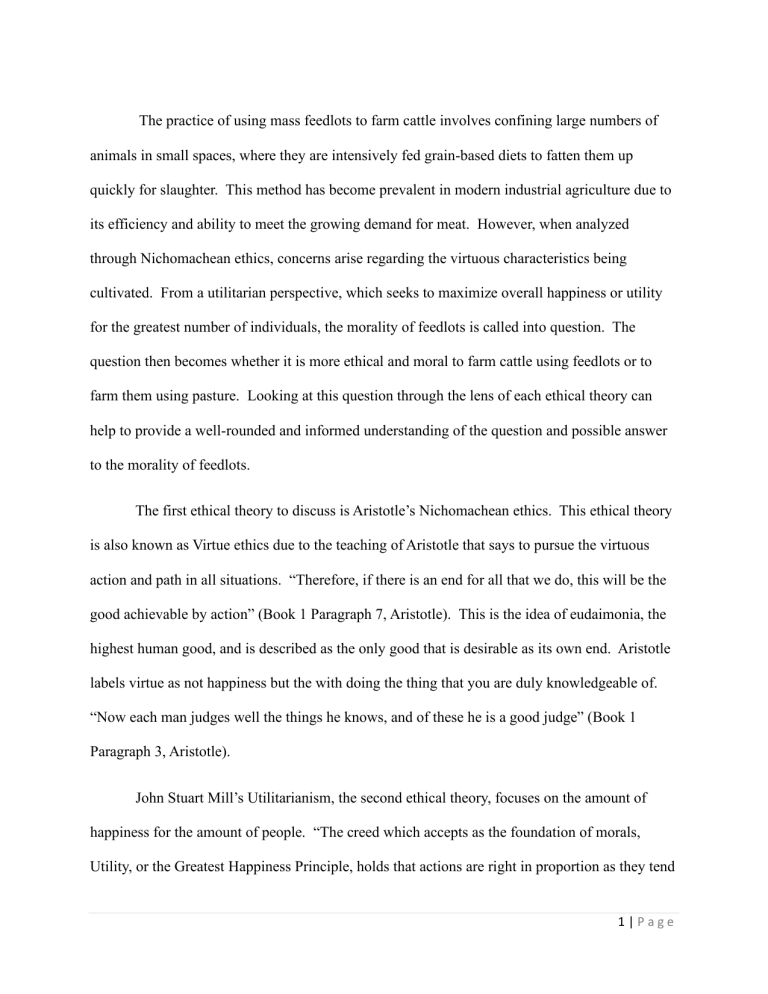
The practice of using mass feedlots to farm cattle involves confining large numbers of animals in small spaces, where they are intensively fed grain-based diets to fatten them up quickly for slaughter. This method has become prevalent in modern industrial agriculture due to its efficiency and ability to meet the growing demand for meat. However, when analyzed through Nichomachean ethics, concerns arise regarding the virtuous characteristics being cultivated. From a utilitarian perspective, which seeks to maximize overall happiness or utility for the greatest number of individuals, the morality of feedlots is called into question. The question then becomes whether it is more ethical and moral to farm cattle using feedlots or to farm them using pasture. Looking at this question through the lens of each ethical theory can help to provide a well-rounded and informed understanding of the question and possible answer to the morality of feedlots. The first ethical theory to discuss is Aristotle’s Nichomachean ethics. This ethical theory is also known as Virtue ethics due to the teaching of Aristotle that says to pursue the virtuous action and path in all situations. “Therefore, if there is an end for all that we do, this will be the good achievable by action” (Book 1 Paragraph 7, Aristotle). This is the idea of eudaimonia, the highest human good, and is described as the only good that is desirable as its own end. Aristotle labels virtue as not happiness but the with doing the thing that you are duly knowledgeable of. “Now each man judges well the things he knows, and of these he is a good judge” (Book 1 Paragraph 3, Aristotle). John Stuart Mill’s Utilitarianism, the second ethical theory, focuses on the amount of happiness for the amount of people. “The creed which accepts as the foundation of morals, Utility, or the Greatest Happiness Principle, holds that actions are right in proportion as they tend 1|Page to promote happiness, wrong as they tend to produce the reverse of happiness” (What Utilitarianism Is, Mill). Mill proposes that the happiness of the individual or small group is much less important than the collective wellbeing of society. He also states that higher pleasures, such as intellectual and moral pursuits, are more valuable than other things that could provide happiness. Utilizing Nichomachean ethics as a lens, using feedlots to farm cattle can be perceived as ethically problematic. Aristotle emphasized the virtue of eudaimonia, a concept that encompasses the flourishing and well-being of individuals and communities. Applying this notion to the use of feedlots, it becomes apparent that the conditions within these establishments do not promote the eudaimonia of the cattle. Feedlots confine animals in small spaces, often creating an environment that is detrimental to their physical and mental health. This practice can be seen as counter to the virtue of justice, as it neglects the animals' inherent rights and fails to treat them with respect. Additionally, the intense use of resources within feedlots, such as large amounts of feed and water, may also run contrary to the virtue of temperance, as it potentially leads to excessive waste. Considering this, the use of feedlots to farm cattle could be viewed as morally questionable according to the principles of Nicomachean Ethics. According to utilitarianism, the morality of using feedlots to farm cattle can be assessed by examining the overall amount of happiness or pleasure versus suffering that it produces for all sentient beings involved. The use of feedlots may be seen as morally justifiable if it leads to a greater overall sum of happiness. Feedlots allow for efficient mass production, contributing to lower costs and greater availability of meat, which may be instrumental in meeting the demand for food in our growing population. However, the suffering experienced by cattle confined 2|Page within feedlots, due to the cramped conditions which limit mobility and potential for unhygienic environments, cannot be ignored. Considering animal welfare and the ethical treatment of animals as essential components of maximizing overall happiness, utilitarian analysis would likely raise concerns about the morality of feedlots as they currently operate. When analyzing the morality of using feedlots to farm cattle from the perspectives of both Nichomachean Ethics and utilitarianism, it is essential to acknowledge that these theories primarily focus on the interests and well-being of human beings. If animals are not considered part of the moral sphere, both ethical perspectives may lead to different conclusions. Nichomachean Ethics might prioritize human flourishing and well-being over animal interests, potentially justifying the use of feedlots if they benefit human beings. Utilitarianism, which weighs the overall happiness and suffering, could still argue that the use of feedlots is justifiable if it leads to greater happiness for human beings, even if animals experience significant suffering. However, it is important to understand that these conclusions may disregard important ethical considerations regarding animal welfare, environmental impacts, and the broader consequences on ecosystems. When assessing the morality of using feedlots to farm cattle, both Nichomachean Ethics and utilitarianism offer valuable insights. From a Nichomachean Ethics perspective, the confinement and treatment of animals in feedlots is ethically problematic as it fails to promote their well-being and neglects their inherent rights. The virtue of justice and the pursuit of eudaimonia, or flourishing, indicate that these practices may be morally questionable. Similarly, utilitarianism scrutinizes the overall happiness and suffering generated by feedlots. While arguments can be made for the potential benefits in terms of meeting food demand, the suffering and adverse environmental impacts associated with these practices cannot be overlooked. 3|Page Ultimately, both ethical frameworks raise concerns about the morality of using feedlots to farm cattle. 4|Page
